Festival Schedule Details for 2024
BACK THIS YEAR! A special all-day pre-Festival bus birding tour on Thursday.
Check out the birding checklist from the entire 2023 Festival, and the butterfly checklist from 2024.
 Pre-Festival Bus Trip (Thu-BT) CANCELLED
Pre-Festival Bus Trip (Thu-BT) CANCELLED
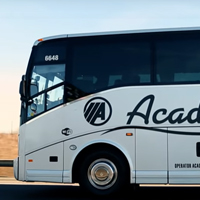
![]() LEADERS:
Dave Goodwin, Jim Eager, Bob Snow, Cole Frederick
LEADERS:
Dave Goodwin, Jim Eager, Bob Snow, Cole Frederick
Seeking Florida's Special Birds - Bus Trip
Saddle Creek Park and Circle B Bar Reserve Bus Trip (includes lunch). The bus will leave FWC’s Suncoast Youth Conservation Center at 7:30 and arrive at Saddle Creek Park, a well-known leading site for fall migratory warblers and songbirds in the mixed hardwood and cypress forest habitats. During migration, over 30 species have been recorded including Bay-breasted, Canada, Cerulean, Golden-winged and Wilson’s warblers. Rarities such as Black-throated Gray Warbler and Philadelphia Vireo have also been seen. The next stop is the Circle B Bar Reserve, a highlight of the Great Florida Birding Trail. We’ll look for alligators, eagles, Osprey, Red-shouldered Hawks, Wild Turkey, Barred Owls, Wood Storks, White Ibis, Sandhill Cranes, moorhens, Pied-billed Grebes, Black-necked Stilts, Red-bellied Woodpeckers, Bobwhite, Eastern Meadowlarks, Savannah Sparrows, American Kestrels, Great Blue Herons, American White Pelicans, sandpipers, spoonbills, Great Egrets, ducks and other waterfowl, and wading birds. We might also see otters, bobcats, grey fox, armadillos, squirrels (gray and fox varieties), frogs, turtles, black racer snakes, five-lined racerunner lizards, and other reptiles. Many migratory birds can be found here. Walk about 2 miles at each site.
This trip is by bus-only. All registrants must meet at the Festival site at 7:00 am to begin boarding. Be sure to bring insect repellant, water, snacks, and a hat, and to wear walking shoes. This tour includes a box lunch.
 Birds of America (Thu-BA) CANCELLED
Birds of America (Thu-BA) CANCELLED
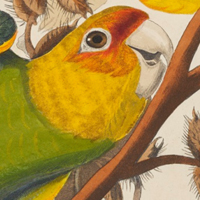
![]() LEADER:
Museum Docent
LEADER:
Museum Docent
"John James Audubon's Birds of America" at the St. Petersburg Museum of Fine Arts
Once the docent-led portion is over, all attendees may view the rest of the Museum's exhibits.
 Coffeepot Bayou (Thu-CB) CLEARED TO GO
Coffeepot Bayou (Thu-CB) CLEARED TO GO
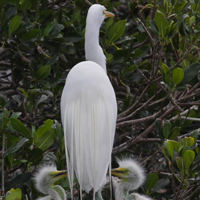
![]() LEADERS:
Ann Paul, Izzy Knott, Kara Durda
LEADERS:
Ann Paul, Izzy Knott, Kara Durda
Coffeepot Bayou Bird Island, Pinellas County - Boat Trip
We have reserved Tampa Bay Watch’s Discovery Eco-Tour boat leaving from the St. Petersburg Pier for an evening field trip to Coffeepot Bayou. Board the boat at the pier area at 6-6:15. We leave the dock at 6:30 and return by 8 at dusk. We travel across Old Tampa Bay to Coffeepot Bayou Bird Island and watch colonial waterbirds up close. Although the birds are not nesting, we will see Brown Pelicans, Anhingas, cormorants, and all the herons and egrets, including state-listed “threatened” Little Blue Herons, Tricolored Herons, and Reddish Egrets, plus Roseate Spoonbills. Audubon Florida’s Coastal Islands Sanctuary staff will provide commentary. Photo credit: Tom Bell
 Outback Key Preserve (Fri-OK) CANCELLED
Outback Key Preserve (Fri-OK) CANCELLED
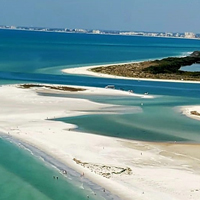
![]() LEADERS:
Eric Plage, Kara Durda
LEADERS:
Eric Plage, Kara Durda
Outback Key and Lower Terra Ceia Bay with Tampa Bay Watch - Boat Trip
This boat trip will go out to a barrier island on the Gulf that is a prime birding spot. You will ride out, then walk parts of the island scanning for shore birds, including Marbled Godwits, Willets, Long-billed Curlews, and plenty of peeps, plus waders and possibly Reddish Egrets. You will then boat into Terra Ceia to the islands of Pinellas National Wildlife Refuge, including Jackass Key, a roost site for Magnificent Frigatebirds! Your leader is a shorebird expert so you’ll get plenty of tips on how to distinguish one from another. Be sure to bring sunscreen, water, snacks, hat, and anything you will want on the boat or island walk. Wear shoes that can get wet so that you can walk on Outback Key. Photo credit: Sam Schnapf
 Se7en Wetlands, Lakeland, Polk County (Fri-SW) CLEARED TO GO
Se7en Wetlands, Lakeland, Polk County (Fri-SW) CLEARED TO GO
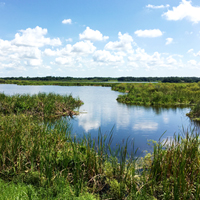
![]() LEADERS:
Dr. Mary Keith, Nicole Barber, Molly Klinepeter
LEADERS:
Dr. Mary Keith, Nicole Barber, Molly Klinepeter
Se7en Wetlands - Wagon Trip
Bring water, snacks. There is a restroom at the office, and one partway around the wetlands.
Se7en Wetlands is a gorgeous example of restoration. Once a phosphate mine, the City of Lakeland owns and operates Se7en Wetlands south of Lakeland. The 1,600 acres of marshes, swamps, uplands, and lakes are designed into a wetland treatment system using seven ponds of various depths. Water circulates from one to the next to provide final polishing treatment for the City’s wastewater with connection to the North Prong of the Alafia River, which flows directly to Tampa Bay. Se7en Wetlands boasts an outstanding and diverse community of plant and animal species. In the spring it hosts a waterbird breeding colony including Roseate Spoonbills and Wood Storks. In the winter American Bitterns and sandpipers use the wetlands habitats Two pairs of Bald Eagles nest there. We will travel by van around the larger wetlands uplands where the incoming water is distributed. We will stop to search for birds, alligators, otters or other wildlife. There will not be much walking, but we will be getting into and out of the van frequently.
Please do not bring large backpacks or bags, since we’ll need the space for sitting!
 Roberts Bay Bird Colony Island (Fri-RB) CLEARED TO GO
Roberts Bay Bird Colony Island (Fri-RB) CLEARED TO GO
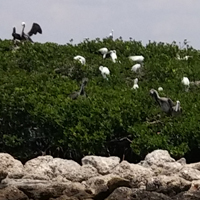
![]() LEADERS:
Megan Ehlers, Kylie Wilson
LEADERS:
Megan Ehlers, Kylie Wilson
Roberts Bay Bird Colony Island on the Carefree Learner - Boat Trip
We’ll cruise south across Sarasota Bay to see the islands, habitat for the largest nesting colony for wading birds and Brown Pelicans in Sarasota Bay. The Roberts Bay Bird Colony has been designated by the Florida Fish and Wildlife Conservation Commission as a “Critical Wildlife Area” and is managed by Audubon Florida. Listed species including Little Blue Herons, Tricolored Herons, Reddish Egrets, Roseate Spoonbills, and American Oystercatchers. We will coast near the three islands and observe the behavior of these beautiful wading birds.
Commentary will be provided by the professional staff of Audubon Florida’s Coastal Islands Sanctuaries. The front parking lot is closed due to downed trees, but there is a smaller lot to the south.
 Cross Bar/Al Bar Ranch (Fri-CA) CLEARED TO GO
Cross Bar/Al Bar Ranch (Fri-CA) CLEARED TO GO
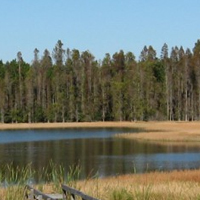
![]() LEADERS:
David Adams,
Alex Reed,
Christine Rowland
LEADERS:
David Adams,
Alex Reed,
Christine Rowland
Cross Bar/Al Bar Ranch, Spring Hill, Pasco County
The 12,500-acre Cross Bar/Al Bar Ranch is managed as a wellfield by Pinellas County Utilities. With wetlands, oak hammock, pine flatwoods, and open pastures, it offers prime birding but is not normally open to the public. Accompanied by the site managers, you will carpool out to check the wetlands for waders and the pastures for Burrowing Owls. Florida Scrub-Jays, Barred Owls and even coyotes are possible sightings. Preferably drive a vehicle with AWD that can handle rough roads. Bring snacks and beverages, as there is nothing available at the site.
 Duette Preserve (Fri-DP) CLEARED TO GO
Duette Preserve (Fri-DP) CLEARED TO GO
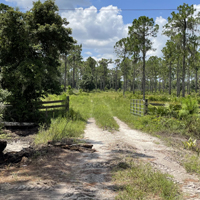
![]() LEADERS:
Aedan Stockdale, Mike Elswick, David Simpson
LEADERS:
Aedan Stockdale, Mike Elswick, David Simpson
Duette Preserve: Natural History, Restoration, and Management - Wagon Trip
Come and take a ride back in time across an austere landscape where grasses, wildflowers, and palmetto still dominate; where longleaf pine stands are being restored, Bachman’s sparrows and scrub jays are thriving. Our wagon comfortably seats 20. Joining us will be the manager of our Education and Volunteer Division, Aedan Stockdale and manager of the Resource Management team Mike Elswick. We’ll discuss the history of the site, the plants and wildlife found there, and the restoration and management efforts past and ongoing.
 Honeymoon Island (Fri-HI) CANCELLED
Honeymoon Island (Fri-HI) CANCELLED
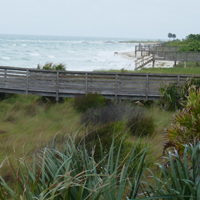
![]() LEADERS:
Dan Larremore, David Simpson
LEADERS:
Dan Larremore, David Simpson
Honeymoon Island State Park, Pinellas County
Honeymoon Island State Park is well known for the migrants it attracts and the many shorebirds that use its beaches. Your leader is the Environmental Specialist for the park, and shorebirds are his specialty, so this should be a great walk! Besides all the plovers and sandpipers, godwits and Willets, Reddish Egrets and oystercatchers along the shorelines, Merlins patrol the edges looking for an unwary breakfast, Great Horned Owls nest in the pine forest on the island, and the Osprey Trail is well named. This trip will focus on shorebirds, how to distinguish them in their winter drab and by their shapes and postures. The back lagoon will probably have the waders who prefer quieter waters. Take a picnic lunch for a post-walk lunch on the beach or at picnic tables near the Osprey Trail at the north end of the park road.
 Cockroach Bay (Fri-CB) CLEARED TO GO
Cockroach Bay (Fri-CB) CLEARED TO GO
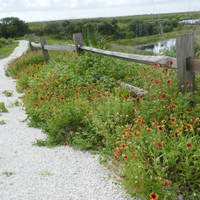
![]() LEADERS:
Mary Barnwell, Travis Blunden, Dave Goodwin, Jim Eager
LEADERS:
Mary Barnwell, Travis Blunden, Dave Goodwin, Jim Eager
Cockroach Bay Aquatic Preserve
The Cockroach Bay Ecosystem Restoration Project represents one of the largest, most complex coastal ecosystem restoration projects ever developed for Tampa Bay. Named for the abundant horseshoe crabs (“roaches”) in the nearby waters, after 20 years the Preserve is a model of habitat diversity. Wading birds will be leaving a nearby night roost. A moderate hike up “Mount Cockroach” offers a view of the tidal and freshwater wetlands and gallinules, Limpkins and egrets. Neotropical migrants abound in the savannah-like landscape. Both White and Glossy ibis frequent the freshwater ponds and wetlands, as do Black-bellied Whistling-Ducks. The area is close to the bay so gulls and terns will sail overhead. Gull‐billed Terns nest nearby and often continue in the area year‐round. Spoonbills use the tidal lagoon, and passerines forage in the old oaks. The freshwater pond to the south is well‐known for the wintering ducks to be found there.
 Upper Tampa Bay Paddling Trip (Fri-UB) CANCELLED
Upper Tampa Bay Paddling Trip (Fri-UB) CANCELLED
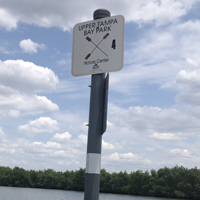
![]() LEADERS:
Ashley Martin, Carol Cassels
LEADERS:
Ashley Martin, Carol Cassels
Upper Tampa Bay Park Habitat - Kayak Trip
Experience a celestial event – the changing of the tides - and the habitats at Upper Tampa Bay Conservation Park during this two and a half-hour kayak adventure! Kayak out Double Branch Creek to Old Tampa Bay with the ebb tide, explore the open bay during the slack, and return to the launch site with the incoming tide. Pass mangrove forests, oysterbars, sand and mudflats, and seagrass beds. Look for American Oystercatchers, herons and egrets, Ospreys, and shorebirds and perhaps manatees and dolphins. Our leaders are County Park Managers and bird experts.
 Boyd Hill Nature Preserve (Sat-BH) CLEARED TO GO
Boyd Hill Nature Preserve (Sat-BH) CLEARED TO GO
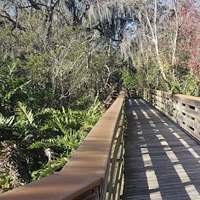
![]() LEADER:
Dave Goodwin,
Jim Eager
LEADER:
Dave Goodwin,
Jim Eager
Boyd Hill Nature Preserve, St. Petersburg
Boyd Hill Nature Preserve is a 245 acre preserve in the middle of south St. Petersburg. Well over 200 species of birds have been recorded here as well as many of Florida’s butterflies. There is also an educational birds of prey aviary in the preserve. It is truly the gem of the St. Petersburg parks! Meet in the parking lot at 7:30 am for a 2-3 hour bird walk. There are restrooms in the Environmental Center and drinking water is provided along the trails. There is a $3.00 admission fee. 1101 Country Club Way S. St Petersburg.
 Blackwater Creek Preserve (Sat-BC) CANCELLED
Blackwater Creek Preserve (Sat-BC) CANCELLED
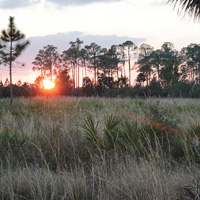
![]() LEADERS:
Rebecca Winch,
Charlie Fisher, Dr. Mark McRae
LEADERS:
Rebecca Winch,
Charlie Fisher, Dr. Mark McRae
Blackwater Creek Preserve, Hillsborough County
This 2,200 acre preserve includes some of the finest remaining examples of long-leaf pine-dominated mesic pine flatwoods and blackwater streams, interspersed with hardwood hammocks, cypress domes, freshwater marshes, and wet prairies. Join Preserve Land Management Staff and expert birders to find Wood Storks, Sandhill Cranes, hawks and herons, sparrows and woodpeckers, and fall migrants. Blackwater Creek’s former cattle pastures and tree farms were acquired between 1997-2003, and are now preserved to allow hiking and wildlife viewing. The site is scientifically managed to preserve these environmentally sensitive lands. Parts of the trail may be flooded due to the rainy weather in August and September. The water on the trail could get to 8 inches deep in some places so there will definitely be some soggy feet. Please wear shoes and trousers that allow walking through water. Due to Hurrican Helene, some of the trails will have ankle-depth water. Water boots are recommended.
 Fort De Soto (Sat-FD) CANCELLED
Fort De Soto (Sat-FD) CANCELLED
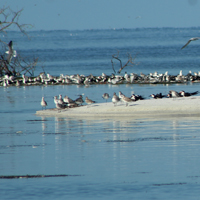
![]() LEADERS:
David Goodwin, Jim Eager
LEADERS:
David Goodwin, Jim Eager
Fort De Soto County Park, Pinellas County
Fort De Soto County Park is a premier birding destination in Florida. More than 250 species of birds have been recorded in the park over the years. Fall migration brings neo‐tropical migratory species to the park as well as occasional wanderers from the Caribbean and the western United States. The island’s shorebird diversity is one of the best on the Florida west coast. This trip is intended for advanced birders, and will be offered on both Saturday and Sunday. You will meet at the flagpole, then drive or walk to the hotspots of the day. Short easy walking at all times. If you care to bring your spoting scope, it will be handy for studying the shorebirds along the beach. If there’s a passerine fallout you’ll be in the wooded areas finding warblers, thrushes and buntings. There’s never a bad day birding at Ft D!
 Alafia Bank (Sat-AB) CLEARED TO GO
Alafia Bank (Sat-AB) CLEARED TO GO
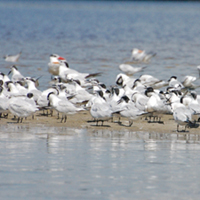
![]() LEADERS:
Carol Cassels, Chris Cooley, Tim Laman
LEADERS:
Carol Cassels, Chris Cooley, Tim Laman
Richard T. Paul Alafia Bank Bird Sanctuary - Boat Trip
Join Audubon Florida’s Sanctuary Managers for a boat trip from the Port of Tampa to the Alafia Bank Bird Sanctuary in Hillsborough Bay. This island sanctuary hosts the largest Roseate Spoonbill nesting colony on the west coast of Florida, as well as being a valuable nesting site for Brown Pelicans, herons and egrets, and White and Glossy ibis. The Alafia Bank has been ranked by the Florida Fish and Wildlife Conservation Commission as Florida’s most important waterbird nesting colony and is an FWC-designated “Critical Wildlife Area”. While October is not the nesting season, we can expect to see a wide variety of waterbirds, including American Oystercatchers, terns, and shorebirds. Mark Rachal will describe restoration, protection, and management of this internationally recognized “Important Bird Area”. On the way, we’ll look for dolphins. Bring your binoculars as we stay on the boat for this field trip. The boat leaves the dock at 8 a.m., so please plan to board by at least 7:45 am.
 Bell Creek (Sat-Bell) CLEARED TO GO
Bell Creek (Sat-Bell) CLEARED TO GO

![]() LEADERS:
Will Laurie, Gina Kent, Adam Kent, Josiah Patrick
LEADERS:
Will Laurie, Gina Kent, Adam Kent, Josiah Patrick
Bell Creek Nature Preserve
This 477-acre Hillsborough County Environmental Lands preserve provides protection for grasslands, oak hammocks, and pine flatwoods plant communities and is a greenway corridor for wildlife. Trails provide access through different habitat areas with mature trees and a varied understory, as well as open areas dominated by grasses and herbaceous species. Warblers, thrushes, tanagers, woodpeckers, hawks, and a variety of neotropical migrants are expected.
 Gibbons Preserve (Sat-GP) CANCELLED
Gibbons Preserve (Sat-GP) CANCELLED
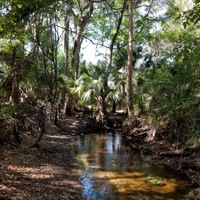
![]() LEADERS:
Nathan LaFata, Logan Lane
LEADERS:
Nathan LaFata, Logan Lane
Gibbons Preserve
The Myron and Helen Gibbons Preserve is a 60-acre forest that has not been logged. The Gibbons family donated the preserve to the Tampa Bay Conservancy, a regional land trust. The 1.5-mile trail crosses Bell Creek and winds through oak and mixed hardwood and cypress wetlands before reaching the shoreline of the Alafia River and looping back to the parking area. Suncoast Native Plant Society members identified over 120 plant species here in 2005. Providing natural shoreline on the Alafia River, this refuge for wildlife protects water quality. Although this trip is mainly an old growth forest riverine habitat walk, you may spot warblers, vireos, woodpeckers, and more in the hammocks, and waders may be along the river’s edge. The trail is narrow, and there are roots. While most is flat, there are some steep spots near the river banks, and spots may be wet, depending on recent rains, so shoes for wading across wet areas are recommended.
 Newman Branch Mangrove Walk (Sat-NB) CLEARED TO GO
Newman Branch Mangrove Walk (Sat-NB) CLEARED TO GO

![]() LEADERS:
Stan Kroh, Jason Chilson, Travis Blunden
LEADERS:
Stan Kroh, Jason Chilson, Travis Blunden
Newman Branch Upland Trail Hike -
Leaving from the Youth Conservation Center, you will paddle Newman Branch, through mangrove tunnels into Seneca Sound, a small embayment that is part of Hillsborough and Tampa bays. You will learn about the species of mangroves and their adaptations for a salty environment and also visit the restored wetlands and uplands of the Newman Branch Restoration project. Possible sightings of birds include night-herons, Little Blue and Tricolored herons, and Reddish Egrets. Photo credit: N. O'Hara
 Schultz Preserve (Sat-SP) CLEARED TO GO
Schultz Preserve (Sat-SP) CLEARED TO GO
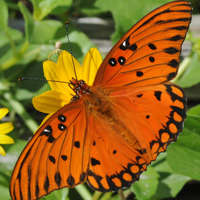
![]() LEADERS:
John Lampkin,
Rob Epstein, Dr. Marc Minno
LEADERS:
John Lampkin,
Rob Epstein, Dr. Marc Minno
Fred and Idah Schultz Preserve, Bugs and Butterflies
The 134-acre Fred and Idah Schultz Preserve, dredged from Hillsborough Bay to create developable land in the 1970s, has been restored over the last 25 years to mangrove forest, coastal and freshwater marsh, coastal dunes, and uplands. The diverse habitats make it THE place for a wide variety of butterflies and other pollinators, including the northern-most colony of Julia Butterflies. Plenty of birds are possible too! Enjoy the nice walk through the varied habitats, but as the walking paths are rough in places, this trip is possibly not suitable for some. There is some shade available but most is sunny, and there are no facilities, so wear a hat and bring water and a snack. Photo credit: MJ Raupp
 Lower Green Swamp (Sun-LGS) CLEARED TO GO
Lower Green Swamp (Sun-LGS) CLEARED TO GO
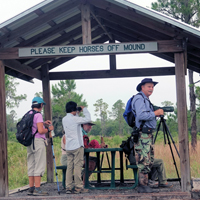
![]() LEADERS:
Adam Kent, Rebecca Winch, Charlie Fisher, Gina Kent
LEADERS:
Adam Kent, Rebecca Winch, Charlie Fisher, Gina Kent
Lower Green Swamp, Hillsborough County
The Lower Green Swamp Preserve, once a working cattle ranch, is being restored to native habitat by Hillsborough County’s environmental lands staff. You will visit only a portion of the 12,800 acres of this preserve, but they are glorious! From the parking area the trail crosses a grassland where Eastern Towhees whistle and bobwhites scurry in the early hours, Loggerhead Shrikes snag grasshoppers, and eagles perch on the power poles. Eastern Bluebirds and Red-headed Woodpeckers share the open wooded and pine areas with vireos and Common Yellowthroats. After crossing Itchepackesassa Creek you’ll enter an open pine flatwoods where Sandhill Cranes, turkeys, and Bachman’s Sparrows rule the roost. At the far end there is a large wetland with Purple Gallinules, Anhingas and Wood Ducks. The trail loops back and follows the creek along an oak hammock dripping with Spanish moss to return to the bridge and then the parking area. Barred Owls and Wood Ducks are sometimes seen along the creek, and of course any migrating warbler will enjoy the insect life it offers. County staff overseeing the restoration will lead the tour to explain and showcase the restoration. Due to Hurricane Helene, the trails are wet. Water resistant boots are recommended.
 Fort De Soto County Park (Sun-FD) CANCELLED
Fort De Soto County Park (Sun-FD) CANCELLED

![]() LEADERS:
David Goodwin, Jim Eager
LEADERS:
David Goodwin, Jim Eager
Fort De Soto County Park, Pinellas County
Fort De Soto County Park is a premier birding destination in Florida. More than 250 species of birds have been recorded in the park over the years. Fall migration brings neo‐tropical migratory species to the park as well as occasional wanderers from the Caribbean and the western United States. The island’s shorebird diversity is one of the best on the Florida west coast. This trip is intended for advanced birders, and will be offered on both Saturday and Sunday. You will meet at the flagpole, then drive or walk to the hotspots of the day. Short, easy walking at all times. If you care to bring your spoting scope, it will be handy for studying the shorebirds along the beach. If there’s a passerine fallout you’ll be in the wooded areas finding warblers, thrushes and buntings. There’s never a bad day birding at Ft D!
 Photography Field Workshop (Sun-PW) CANCELLED
Photography Field Workshop (Sun-PW) CANCELLED
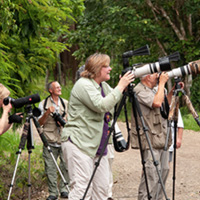
![]() LEADER:
Reinier Munguia
LEADER:
Reinier Munguia
Photography Field Workshop, Circle B Bar Reserve
Reinier Munguia has led photography field workshops for 20 years, all over the world. Participants will learn photographic techniques and develop skills to create better images. This workshop will be at the Circle B Bar Reserve, among the best regional birding spots. Shallow wetlands intersected by raised levees for walking support habitat for Purple Gallinules, Black-bellied Whistling-Ducks, Sora, American Bitterns, and more. Bald Eagles patrol the area, and previous trips have found both Peregrine Falcons and Merlins. Wildlife includes alligators and marsh rabbits. Wintering White Pelicans still leave room in the deeper lakes for ducks. Reinier says, “Wildlife photography is not about taking pictures, but to create images that portray nature at its best.” Everyone must meet at the gazebos by the main parking.
 Celery Fields (Sun-CF) CLEARED TO GO
Celery Fields (Sun-CF) CLEARED TO GO
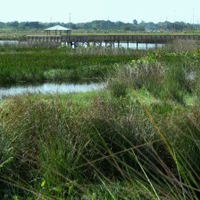
![]() LEADERS:
Lisa Sykes, Jeanne Dubi, David Simpson
LEADERS:
Lisa Sykes, Jeanne Dubi, David Simpson
Celery Fields, Sarasota County
This 400‐acre stormwater retention area in eastern Sarasota County is one of the Gulf Coast’s best birding hot spots. The former aqricultural fields have been restored to a meandering stream with wetlands and grasslands nestled among the curves. A hill with walking and equestrian trails overlooks the area, and two boardwalks allow access to the stream and marsh. With 220 species recorded at the site, the swamp and open water environment is a haven for Limpkins, bitterns, rails and herons. The Least Bitterns do not know that they are ‘shy and retiring’ here, Peregrine Falcons sail overhead, and variety of fall sparrows spend the winter. Depending on water level, shorebirds, waders and ducks may be abundant. Sarasota Audubon provides volunteer Bird Naturalists at each of the two boardwalks to help visitors identify birds and plants. The Nature Center with native plant gardens is also available for visitors to enjoy. Walks are on even paths or short boardwalks, but there is little shade and only a few benches. On your way in scan the ponds on either side of Coburn/Apex Rd for waterbirds as well.
 Bird Banding (Sun-BB) CANCELLED
Bird Banding (Sun-BB) CANCELLED
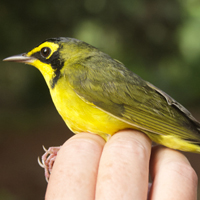
![]() LEADERS:
Jim McGinity, Steve Aversa, Paul Trunk
LEADERS:
Jim McGinity, Steve Aversa, Paul Trunk
Birding and Banding in Hammock Park, Dunedin
Come learn about bird banding, observe how ornithologists use it to learn about and conserve migratory birds, and enjoy our fall migratory birds while birding this 100‐acre city park. The hammock’s hardwoods and sabal palms attract numerous resident and migratory species. The Fern Trail in particular is known for having banner days in fall migration. You will observe the banding station action, seeing some of the local migrants up close while researchers measure, weigh and band them. Some participants will get a chance to release banded birds! You will also walk sections of the park and boardwalk to see what else is lurking in the bushes, along the stream, or zipping through the trees overhead. Warblers, vireos and thrushes are all good bets in the bushes, Golden-winged, Bay-breasted, Kentucky, Blackburnian, Canada and Cerulean warblers have been seen here, along with Baltimore Oriole, Black-billed Cuckoo, Veery, Wood Thrush and Scarlet Tanager. Herons, egrets, and night-herons wade the tidal stream. Osprey and Barred Owl occur year round, and winter brings ducks, rails, sandpipers and a multitude of sparrows. Raptors scan for the unwary over the open fields. The walk is easy, flat, not more than 2 miles.
 Egmont Key (Sun-EK) CANCELLED
Egmont Key (Sun-EK) CANCELLED
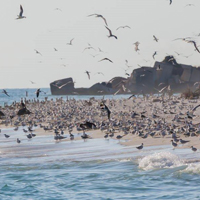
![]() LEADERS:
Barb Howard, Dave Howard, Dr. Mary Keith
LEADERS:
Barb Howard, Dave Howard, Dr. Mary Keith
Egmont Key National Wildlife Refuge/State Park - Boat Trip
Join the Fish and Wildlife Service staff and Friends of the Tampa Bay National Wildlife Refuge for a special boat cruise to Egmont Key National Wildlife Refuge/State Park in Pinellas County. Established in 1974 to protect migratory birds, the island is situated at the mouth of Tampa Bay and is also the site of historic Fort Dade. Three hundred soldiers served at the fort from 1898-1923 and the restored guardhouse is listed on the National Register of Historic Places. The lighthouse, built in 1858, is still used for navigation. A key migratory bird fall-out site in fall migration, in most years, the island hosts a large seabird and pelican colony during the spring nesting season. We expect to see warblers, other songbirds, raptors, gulls, terns, and other seabirds. Unless you choose to walk on the beach, the inland paths of the island are paved or brick, so the walking is easy.
 Roosevelt Wetlands (Sun-RW) GOOD TO GO
Roosevelt Wetlands (Sun-RW) GOOD TO GO
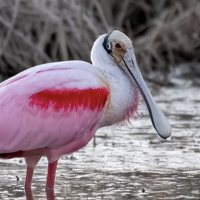
![]() LEADER:
Dave Goodwin, Jim Eager
LEADER:
Dave Goodwin, Jim Eager
Roosevelt Wetlands, Pinellas County
Roosevelt Wetlands is a storm water treatment wetland with an access trail (1.2 miles) leading through and around the ponds. 81 species have been seen here this month so far. There are no facilities or water at this location which has become popular with local birders in Pinellas County in recent years. 10853 43rd Street N.
 Terra Ceia Preserve (Sun-TC) CANCELLED
Terra Ceia Preserve (Sun-TC) CANCELLED
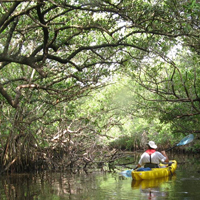
![]() LEADER:
Randy Runnels
LEADER:
Randy Runnels
Frog Creek & Terra Ceia Paddling Trip - Paddling Trip
Tampa Bay has relatively few natural, unobstructed tidal creeks left, and Frog Creek is one of the least developed and most species-rich. In a leisurely-paced paddling trip of a little over 2 miles, participants will experience a dramatic change in biota over a gradient from freshwater, with overhanging oaks, leather ferns, and sawgrass-lined shores to saltwater, through a significant mangrove forest and around oyster bars. This is an excellent foraging area for a variety of coastal bird species. Participants will need to paddle for a little over 2 miles, but it is at a leisurely pace and downstream. Canoes or kayaks will be provided, and you are welcome to bring your own if you prefer (but no discount is offered). Sunscreen, bug spray, and bottled water will be supplied.
Our expert-led seminars take place all day on Friday and Saturday. All of the seminars are included with the Festival registration. Most presentations begin each hour starting at 9:00 am.
Bird Photography
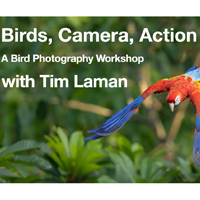
![]() SPEAKER:
Tim Laman
SPEAKER:
Tim Laman
Birds, Camera, Action Part 1
These talks are aimed at beginner to moderately experienced bird photographers, but even veterans might gain some insights by learning how Tim approaches different situations in the field.
From setting up your camera in "Ready for Action" mode, to making the most of your autofocus system and exposure modes for different situations, Tim covers the fundamentals of successful bird photography. Attendance limited to 75.
Bird Photography

![]() SPEAKER:
Tim Laman
SPEAKER:
Tim Laman
Birds, Camera, Action Part 2
These talks are aimed at beginner to moderately experienced bird photographers, but even veterans might gain some insights by learning how Tim approaches different situations in the field.
Building on Part 1, in this presentation Tim will elaborate further on managing exposure in various situations and share his tips for photographing birds in flight and getting creative with capturing birds in action. Attendance limited to 75.
Killer Whales
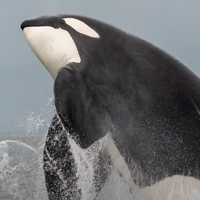
![]() SPEAKER:
Tom and Lindsay Bell
SPEAKER:
Tom and Lindsay Bell
Killer Whales
Southern Resident Killer Whales are severely endangered. A significant problem to their survival is the death rate of their young. A couple of years ago the world watched while one of these mother whales carried her dead calf on the water’s surface for over two weeks while she grieved. Finding an unexpected ally, researchers are applying aspects that have been learned about the endangered mountain gorillas in Africa to this whale’s plight. Although very different species, their similarities may inspire the survival of this whale population. Lindsay and Tom Bell will share many of their personal experiences with and their amazing photos of these magnificent Orcas.
Birding 101
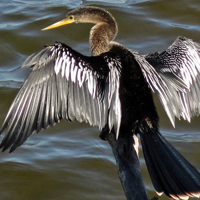
![]() SPEAKER:
Travis Blunden
SPEAKER:
Travis Blunden
Birding 101
Curious about the many different birds around you? Do you wonder why people travel across the state, the country, and even the world to look at birds? Designed for the beginning or casual birder who wants to learn more, Travis Blunden in Birding 101 explains what birding is, what you need to get started, and lots of tools and tips to help you learn “how to do it”. Topics include choosing binoculars, identification, using field guides, cell phone applications, and online tools. Be warned: Birding can be addictive!
Migration

![]() SPEAKER:
Dr. Mary Keith
SPEAKER:
Dr. Mary Keith
Birds Do It, Bees Do It... Migrate, of course!
Mary Keith’s talk will provide a quick look at who, what, why, where, and when birds migrate. She will describe some of the new technology that scientists use for tracking where the birds are going. And she will point out where to go in what season to look for birds migrating in Florida. Finally, she will explain the latest we’ve learned on how on earth the birds know where they’re going.
Florida Scrub-Jay Conservation
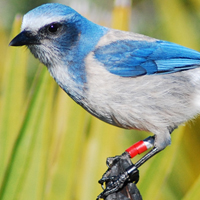
![]() SPEAKER:
Dr. Raoul Boughton
SPEAKER:
Dr. Raoul Boughton
A Long-Term Commitment to Florida Scrub-Jay Conservation: What do we do next?
Once phosphate mining is completed, reclaimation of the mine site involves return of diverse native communities and rewilding with endangered and rare vertebrate species. The Mosaic Florida Scrub-Jay (Aphelocoma coerulescens) Program relocates birds to a different location, enhances the habitat there, commits to protecting these relocated populations in perpetuity, recolonizes former populations, and rescues populations through translocations and reclaiming scrub habitats on mined lands.
The conserved area for this Habitat Management Plan includes the North and South Wellfield and partnership with Manatee County’s Duette Preserve and the South Florida Water Management District’s Coker Tract. These sites offer native scrub and scrubby flatwoods but require habitat management with fire for Florida Scrub-Jays. For the last 20 years, Mosaic has conserved these sites, undertaken habitat management, supported research concerning the success of translocation, and monitored the long-term population results. Building on past efforts, the project has grown the 14 impacted groups to more than 40 groups and 120 adults. Learn about Florida Scrub-Jay conservation and Mosaic’s commitment to recovery of the species.
Gopher Tortoise Conservation

![]() SPEAKER: George L. Heinrich
SPEAKER: George L. Heinrich
Remnants of a Forest: Gopher Tortoise Conservation on Small Public Lands
Gopher tortoises (Gopherus polyphemus) are ecosystem engineers that create extensive burrow systems and disperse seeds, significantly contributing to upland habitat biodiversity. This presentation will examine the value of gopher tortoise conservation on small public lands, as well as address the challenges of managing natural areas bordered by urban interface. Photo credit: George L. Heinrich
Sediment Invertebrates
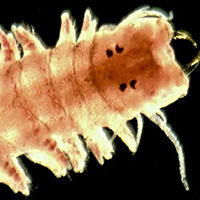
![]() SPEAKER: Dave Karlen
SPEAKER: Dave Karlen
A Worm's Eye View of Tampa Bay: What sediment invertebrates tell us about the health of our Bay
Benthic Ecology is the study of bottom habitats in the marine and freshwater environments. The invertebrate community living on (epifauna) and in (infauna) the bottom sediments are an important component of the marine food web and influence the cycling of nutrients between the sediment and water column. The benthic community also serves as an important indicator of the overall health of the marine environment and are often used in monitoring programs. The Environmental Protection Commission of Hillsborough County has been conducting annual benthic monitoring in Tampa Bay since 1993 in partnership with the Tampa Bay Estuary Program and Pinellas and Manatee Counties. This presentation will give a general overview of the field of Benthic Ecology and how benthic communities are utilized in environmental monitoring and more specifically, summarize results from 30 years of benthic monitoring in Tampa Bay in relation to long-term water quality trends.
Butterflies

![]() SPEAKER: Dr. Marc Minno
SPEAKER: Dr. Marc Minno
Florida's Butterflies
Marc Minno, an expert on endangered butterflies and their habitats, has literally written the books on Florida’s butterflies. He will share fascinating facts about these beautiful insects, including which ones we can see here, what they do and how we can interpret their behaviors, where they live, what their caterpillars eat, how they are doing in Florida, and how we can invite them to share our world. He loves butterflies, and his engaging talk is inspirational and highly informative. Photo credit: MJ Raupp
Herons & Egrets
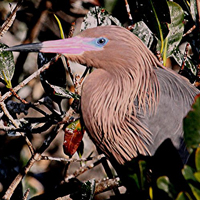
![]() SPEAKER:
Ann Paul
SPEAKER:
Ann Paul
Herons & Egrets
Florida boasts twelve species of herons. Among our most iconic and rarest birds, the herons are specialists designed to specifically target certain prey. Ann Paul will share details about their plumages, foraging and mating behaviors, why some herons are egrets and some are not, distribution, populations status, and conservation concerns. Photo: Tom Bell
Dolphins
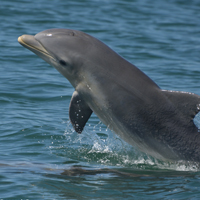
![]() SPEAKERS: Dr. Katie McHugh
SPEAKERS: Dr. Katie McHugh
The Dolphins of Sarasota Bay: Lessons from 50+ years of dolphin research and conservation along Florida's coast
We all share the coastal environment with dolphins and other wildlife who call our local waters home. Learn more about Florida's dolphins and their estuarine and coastal habitats from the world's longest-running dolphin conservation research program - the Chicago Zoological Society's Sarasota Dolphin Research Program. Dr. McHugh will share findings from 50+ years of work along the Gulf Coast as well as opportunities to engage with dolphin conservation.
Bald Eagles
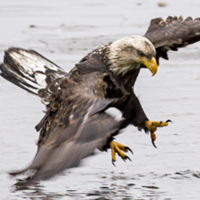
![]() SPEAKER: Stephen Nesbitt
SPEAKER: Stephen Nesbitt
Surveying Florida's Bald Eagles: 1972 to 2017
Stephen Nesbitt conducted the statewide Bald Eagle surveys for the State of Florida as staff for the Florida Fish and Wildlife Conservation Commission for 40 years. He will explain how survey methods changed over the years, what he learned about the population during that time, and how that knowledge was applied to the statewide and region-wide management of the species. Photo credit: Tom Bell
Imperiled Birds
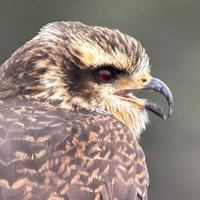
![]() SPEAKER: Adam Kent
SPEAKER: Adam Kent
Florida's Imperiled Birds
Florida has one of the highest concentrations of threatened and endangered birds in the United States. We’ll discuss how and why birds are listed and what’s being done to protect them now. Plus, we’ll talk about where to find many of these captivating birds!
Snail Kite and Prey
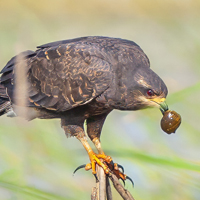
![]() SPEAKER: Gina Kent
SPEAKER: Gina Kent
The Snail Kite and the Apple Snail: An endangered, nomadic, wetland specialist's relationship to prey availability
The Snail Kite’s U.S. distribution is limited to Florida. Snail Kites feed almost entirely on a single species, the Apple Snail, which is influenced by the timing and distribution of surface water conditions. Striking declines in Snail Kites have been directly tied to human-caused changes in hydrology which affect the availability of the kite’s food source and safe nesting locations. By tracking the Snail Kites’ movements with GPS-trackers, we identify foraging spots to sample the density of Apple Snails and understand what habitat characteristics best attract and support the birds. The GPS locations of the kites also allow us to identify nesting and roosting sites as well as long-distance tracks we can use in management recommendations for this endangered raptor.
Save money! Attend both keynotes for $60 and save $20.
DAVID SIBLEY Author
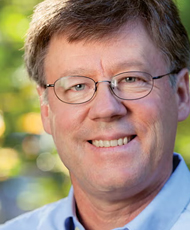
American Ornithologist
The Psychology of Bird Identification.David Allen Sibley is the author and illustrator of the series of successful guides to nature that bear his name, including the New York Times bestseller The Sibley Guide to Birds. He has contributed art and articles to Smithsonian, Science, The Wilson Journal of Ornithology, Birding, BirdWatching, and North American Birds, and wrote an illustrated a syndicated column for The New York Times. He is the recipient of the Roger Tory Peterson Award for Lifetime Achievement from the American Birding Association and the Linnaean Society of New York’s Eisenmann Medal. He lives in Deerfield, MA.This keynote event includes a buffet meal, and will be held at the St. Andrew Presbyterian Church in Sun City Center.
TIM LAMAN Biologist and Filmmaker
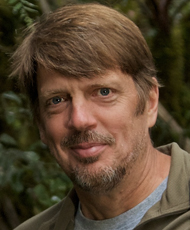
Bird Planet - A Photography Journey
This keynote event includes a buffet meal, and will be held at the Sun City Center Community Center in Sun City Center.
Birds inhabit every continent and major island and are conspicuous and loved by many. For ornithologist and National Geographic photographer Tim Laman, documenting these magnificent creatures has been a lifelong passion that has taken him from the Antarctic peninsula to the uninhabited Foja Mountains of New Guinea and more than one hundred other locations around the world. In his keynote, Tim will share his favorite bird photographs from over twenty-five years in the field, along with some of his most memorable adventures in pursuit of them. Covering a broad range of species from diverse habitats - from hornbills in the rainforest of Borneo to cranes in snowy Hokkaido, and from birds of paradise in the tree-tops of New Guinea to wandering albatross soaring over the Drake Passage, Tim's images of birds in their natural habitats are sure to inspire a greater appreciation for birds and the importance of protecting their environment, not just for the birds, but for all life on earth.
Tim Laman is a field biologist, wildlife photojournalist, and filmmaker. Since getting his Ph.D. from Harvard for pioneering research in Borneo’s rainforest canopy, his cameras have been his tools for telling the stories of rare and endangered wildlife and revealing some of earth’s wildest places. He has photographed on all seven continents, and regularly travels to some of the most remote corners of the earth to explore and document poorly known species. He is most well-known for his long-term work on birds-of-paradise and orangutans. He has published 24 feature stories in National Geographic magazine, as well as worked on natural history films for National Geographic, the BBC, and Netflix. Tim’s work has garnered numerous awards, including the overall prize Wildlife Photographer of the Year in 2016, a 1st place Nature Story from World Press Photo, and the North American Nature Photography Association’s “Nature Photographer of the Year”. Tim is a fellow of the Explorer’s Club and of the International League of Conservation Photographers, as well as the co-founder of the Birds-of-Paradise Project at the Cornell Lab of Ornithology.
Nature and Birding Exhibitions and Vendors
Open from 10:00 am to 5:00 pm on both Friday and Saturday, the free expo will be full of great finds!
Lunches will be available for purchase each day from 11:00 am to 2:00 pm.
Check out the growing list of organizations that will be there under EXPO on our Home Page.